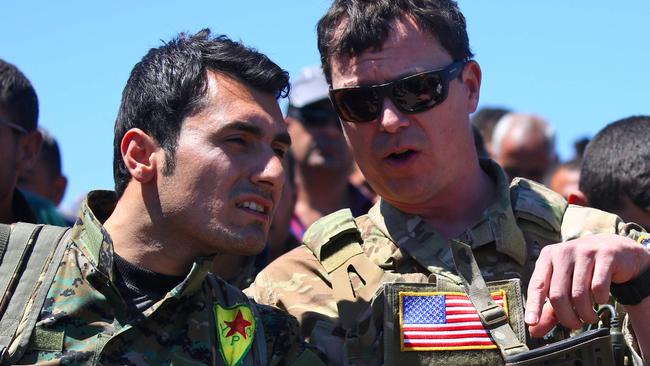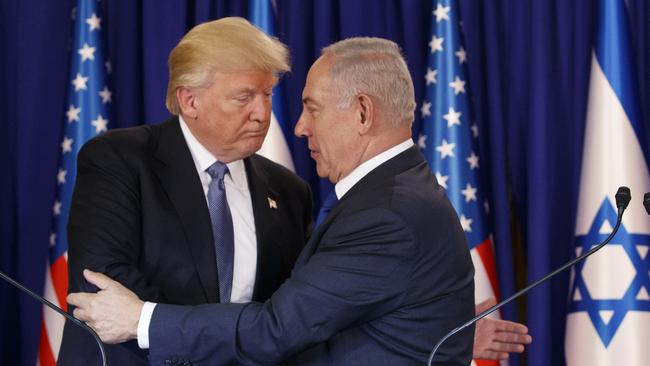Trump and Syria: Withdrawal symptoms
Critics ignore the merits of Donald Trump’s Syrian strategy.

Donald Trump’s decision to bring all US troops home immediately from Syria has prompted predictable outrage from foreign policy hawks, who see the move as ceding influence to Iran, Russia and Hezbollah.
These concerns — along with rumours of an imminent similar withdrawal from Afghanistan — likely triggered Defence Secretary Jim Mattis’s abrupt resignation announcement, issued late on Thursday, Washington time.
Mattis was expected to leave soon anyway and Trump has been telegraphing discontent with him for some time, but the combination of sharp policy differences and the way the President blindsided his Department of Defence seems to have been the last straw for the long-suffering Defence Secretary.
The Syria decision has provoked deep disquiet among counter-terror experts, who point out that Islamic State is far from defeated and that abandoning the Syrian Kurds, who have fought so hard against the group, will make it difficult to rally local allies when it inevitably re-emerges. It also has evoked comparisons with Barack Obama’s disastrous 2011 withdrawal from Iraq, which enabled the rise of Islamic State in the first place.
Despite the harsh reaction, though, it’s worth acknowledging that Trump is dealing with exceedingly complex circumstances in Syria — more so, in many ways, than any Obama faced. The Assad regime has recovered from its near-death experience of 2015, recaptured all of Syria’s major cities, and now controls the entire country except for the northeast (held by Kurds and smaller tribal forces), Idlib province (controlled by a group of jihadist factions) and pockets in the far south and east. Iran and Russia are consolidating their influence in Syria, and would be doing so with or without a US presence, while Hezbollah has emerged as a major regional player with strategic depth for any future war with Israel.

For its part Turkey, a key NATO ally but with starkly different regional interests from the US, has made it clear that its patience has run out in the context of Washington’s partnership with the Syrian Kurds, and that it plans to launch an offensive against Kurdish forces east of the Euphrates in the near future.
It’s of critical importance to Trump that this decision delivers on a campaign promise to bring the troops home. As the President correctly pointed out on Thursday, he has been campaigning on this issue for years, and now he is putting his longstanding desire for disengagement into effect. This is true not only in Syria: in Afghanistan (where the administration has been pursuing talks with the Taliban across several months) and Yemen (where US negotiators pressured warring parties into a recent ceasefire), Trump consistently has pushed to end the conflicts he inherited.
Indeed, he was only reluctantly persuaded to maintain the US presence in Afghanistan last year, bowing to pressure from Mattis and national security adviser HR McMaster, both of whom are now gone. The President frequently has complained about what he perceives as a stalemate in Afghanistan. As the week ended in Washington, rumours swirled about a potential withdrawal of all 14,000 US troops from Afghanistan next year — a move that would be similar to what Trump announced for Syria this week but on a much larger scale and with potentially dire consequences.
American negotiators holding talks with the Taliban since mid-year reportedly have discussed US troop withdrawal as one condition for peace negotiations. This would mark a departure from US policy (which has treated peace talks as a precondition for withdrawal), but the desire to pull the troops back, disengage from the conflict and refocus efforts narrowly on countering al-Qa’ida and Islamic State (both of which have a significant presence in Afghanistan) would fit neatly into Trump’s approach.

In Syria, he also has defined the conflict very narrowly as a campaign against Islamic State rather than an open-ended engagement or a regional counter to Iran. One can easily imagine a different president being praised by the foreign policy establishment for showing restraint, leading from behind and avoiding “mission creep” in the Middle East; not this President, of course, but arguably for reasons that have nothing to do with the facts on the ground.
Those facts are broadly in Trump’s favour, though not completely. Islamic State no longer controls significant territory or population in Syria — and though it still has thousands of fighters, it has reverted to guerilla mode, with scattered bands of insurgents infesting remote hill tracts and desert areas, and terrorist cells targeting government-held cities.
The campaign as it existed until the fall of Raqqa, Islamic State’s de facto capital, in October last year — in which a conventional ground manoeuvre by local forces, backed by Western air power, artillery and special forces advisers, was decisive — no longer exists. The main effort now comprises patient intelligence work, policing, stabilisation and reconstruction, and counter-insurgency, all tasks that are better led by locals.
Thus, at this point, other than acting as a trip-wire to deter a Turkish move against the Syrian Kurds, it’s unclear what 2200 American special forces troops and a few dozen diplomats and aid officers can do in Syria that can’t already be done by US forces in Iraq or by surveillance satellites and strikes from drones and piloted aircraft.
We know this is how Trump conceives of the situation because he has repeatedly said so.
More broadly, as I wrote earlier this year, the President seems to be turning to what some strategists call “offshore balancing”, where an external power seeks not to dominate directly or occupy a given region but merely to prevent any rival power or combination of powers from controlling it.
This approach has a long and honourable pedigree: it was Britain’s strategy towards Europe through much of the 18th and 19th centuries, and the Americans’ preferred approach to the Middle East until the 1990s. An offshore balancing framework also explains much of Trump’s attitude towards Europe and NATO.
Offshore balancing, in this context, would mean disengaging from large-scale forward missions, bringing the bulk of American combat forces back to regional bases or returning them to the US, countering Iran through allies such as Israel, Saudi Arabia and the United Arab Emirates rather than directly, and using a light-footprint screen of drones, warships, airstrikes and special operators working with local partners to stop terrorist threats re-emerging.
It would mean relying on the Russians and Iranians to combat Islamic State while letting Israel, Turkey and Saudi Arabia counterbalance Iran. At its crudest, it might involve “fighting Islamic State to the last Russian mercenary”, and it certainly would involve allowing Syria’s President Bashar al-Assad — who, after all, has the strongest motivation of any player — a free hand in re-establishing control over Syria, despite his atrocious human rights record.
Should the mooted withdrawal from Afghanistan take place, it would imply leaving the Afghans to deal with the Taliban essentially on their own, while recasting US efforts in the region much more narrowly, on purely counter-terrorism terms.
This policy is undeniably cynical and its results undoubtedly would be ugly. But it holds the immense advantage that, if successful, such a strategy would allow the US to extricate itself from two decades of inconclusive wars of occupation in the greater Middle East and Afghanistan while preserving some ability to block Iran and continuing to target the terrorists who triggered the post-9/11 interventions. This is, in fact, is a pretty good description of Trump’s approach.
Of course, there were the inevitable Trumpian flourishes and oddities in the way the decision was communicated. Mattis’s resignation is just the tip of the iceberg: the President’s abrupt announcement apparently took his entire team by surprise. The move contradicted recent statements by everyone from National Security Adviser John Bolton and Brett McGurk, special envoy to the anti-Islamic State coalition, to James Jeffrey, the special representative for Syria engagement.
The State Department, at a loss for talking points, abruptly cancelled its Wednesday afternoon press briefing while diplomats scrambled to engage with allies. Trump’s friends in congress, including senators Lindsey Graham and Bob Corker, chairman of the foreign relations committee, as well as the heads of other congressional committees were not consulted and loudly expressed their concern.
But again, at this point in his administration, Trump’s Twitter-driven style should surprise no one and, despite the open rift with Mattis, in its substance the President’s decision is a defensible one, albeit with extraordinarily painful consequences.
These consequences largely will fall on the Kurds and other local partners, such as the Shammari tribal confederation in Syria’s northeastern Hasakah region, and the southern rebel front partnered with US forces just inside Syria’s border with Jordan. There’s no indication Trump is unaware of these consequences; rather, he seems to regard them as an unfortunate side effect of a necessary strategic decision. Faced with the prospect of fighting Turkey to defend the Syrian Kurds, he has chosen to declare victory and leave.
Even realists should not skip over these side effects lightly. Turkey is indeed likely to use the coming northern winter to move against the Kurds, and hastily abandoning them — which is what the proposed withdrawal timeline of a mere 30 days amounts to — will lead to civilian casualties and harm one of our most reliable regional partners. US withdrawal also will likely prompt Kurdish leaders and local sheiks to make accommodations with the Assad regime to survive and, as the Kurds themselves pointed out, force them to turn away from efforts against Islamic State.

Besides, local tribes and separatist movements that might have been potential future allies will be reminded that the US often can be unreliable — though anyone still unaware of that fact clearly has not been paying attention.
However, predictions of an impending massacre or of the Kurdish enclave being overrun are probably exaggerated at this point. The two largest factions in the Kurdish region — the Syrian Democratic Forces and the People’s Protection Units (YPG in Kurdish) — between them have more than 45,000 troops. Both groups have well-organised, well-armed and experienced combat forces with a reputation for toughness and competence. Turkish objectives are likely to be limited to creating a shallow buffer zone across the Euphrates to separate the Syrian Kurds from the Kurdish-majority parts of Turkey, something hawkish Turkish politicians have been pushing since 2015, rather than extending to crushing the Kurds entirely.
At a deeper level, this decision seems to reflect an attempt by Trump to resolve fundamental inconsistencies in the US strategy for Syria, which have been obvious since 2011. In effect, since mid-2014, when the Islamic State blitzkrieg into Iraq forced Obama to stop ignoring the group, Washington has been fighting Assad’s main enemy (Islamic State) while seeking to counterbalance his main allies (Russia and Iran). This has generated four incompatible objectives: to defeat Islamic State; to contain Iran and Hezbollah; to protect Israel and the Kurds; and to balance Turkey and the Saudis.
As the war has progressed — and particularly since the August 2013 failure to uphold the “red line” against Syrian use of chemical weapons, and Russia’s direct intervention in September 2015 — maintaining all these goals simultaneously has proved impossible.
Was the effort in Syria sustainable? Mattis clearly thought so and, in strictly militarily terms, he almost certainly was right: fewer than 2500 troops could be considered a relatively light footprint, especially since they were primarily advisers and the President had already cut the budget for reconstruction in the region.
In constitutional terms, an extended mission to counterbalance Iran would have been extremely doubtful, as David French pointed out in a well-argued piece in National Review one day before Trump announced the pullout, thereby rendering the argument largely moot.
In political terms, the commitment to Syria was uncomfortable for the President because of his election promises but it probably was small enough (and invisible enough) to be sustainable. So, on balance, although Trump could have maintained the commitment, he clearly has chosen to rebalance — to use an Obama-era term — away from forward commitments towards an offshore balancing approach.
Looking ahead, we can expect continued airstrikes and special forces raids against Islamic State in the region and, if the withdrawal from Afghanistan goes ahead, across the Afghanistan-Pakistan region, too.
The threat is real: Islamic State is already rebuilding its networks in Syria and Iraq, it recently has mounted attacks on cities across the region, it has a strong presence in Afghanistan and, although it has lost about 98 per cent of the territory it once controlled, it retains the ability (and intent) to recover and threaten the stability of the wider region.
Islamic State has 15,000 to 17,000 fighters across Syria and Iraq, at a minimum. Some UN and Pentagon estimates put the numbers as high as 20,000- 30,000, but by definition this is extremely hard to estimate. US bombing alone is unlikely to destroy the group, but keeping 2200 special operators permanently in Syria would not have done so either. On Assad’s part, we can expect his regime’s internal weaknesses to come to the fore as he gets closer to crushing the rebellion in the coming year.
Defeating the rebels is one thing, governing and reconstructing Syria entirely another: at this point Assad lacks the legitimacy, and his administration lacks the competence and coherence, to control the country without massive brutality.
As usual Israel — a frontline state confronting an enhanced Iranian presence, greater Hezbollah influence, potential Turkish intervention and a Syrian regime that remains caught in its own internal chaos — has taken a characteristically balanced view. Prime Minister Benjamin Netanyahu has announced that Israel is “studying the situation”, noting that the US retains other ways to influence the region beyond direct occupation, and he has vowed to take whatever action is needed to preserve Israel’s security. As Trump’s critics wait for the decision to withdraw from Syria, and potentially Afghanistan, to play out across the next few months, they would do well to adopt a similar approach.
David Kilcullen was a senior adviser to US general David Petraeus in 2007-08, when he helped to design and monitor the Iraq war coalition troop surge, and was a special adviser for counter-insurgency to US secretary of state Condoleezza Rice. His most recent book is Blood Year: Islamic State and the Failures of the War on Terror (Black Inc).




To join the conversation, please log in. Don't have an account? Register
Join the conversation, you are commenting as Logout